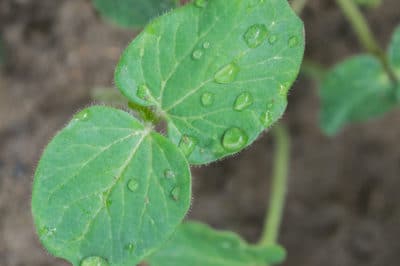Why Okra’s Taproot Matters
Okra’s root system grows out from a long taproot, so all of the moisture and nutrients gathered from the soil return to that taproot before being sent up to the rest of the plant. If the taproot is injured or the rest of the root system is disturbed, the ability of the root system to gather moisture and nutrients and send the up to the leaves, flowers, and pods is disturbed or damaged, and the plants suffer for it and even die as a result. So successfully growing okra from seedlings requires taking precautions to avoid disruptions to the root system, but especially to the tap root.
When to Start Your Okra Seedlings
One way to decide when to start your seedlings is to count back six to eight weeks from when the weather in your area remains consistently warm. If you aren’t using a grow tunnel or a cold frame, that is when you will want to transplant it. You can also count back three to four weeks from the last frost date in your area which means that your okra should be ready for transplanting about two weeks after that last frost date.
Okra does not tolerate frost well, and for okra to grow well, daytime temperatures should be remain close to 85°F (29°C) with nighttime temperatures around 60°F (16°C). This should be enough to warm the soil temperature to 65°F (18°C). There are thermometers for measuring soil temperature, just in case you’re wondering, but a meat thermometer also works.
Using Grow Tunnels and Cold Frames
Grow tunnels and cold frames usually are used to create greenhouse-like warmth for plants that are sown directly into the ground. However, you also could transplant your okra inside a frame or tunnel. Transplanting your seeds inside of a tunnel or frame means that you could sow your seeds two weeks earlier so that your seedlings can be transplanted about the time of the last frost date instead of two weeks after it.
If you are concerned that temperatures may be too cool for your okra, you can use a row cover under a grow tunnel for extra protection, or you cover plants in grow tunnels or cold frames with sheets. You can also fill 1-gallon milk jugs with water and place them inside the cold frame or grow tunnel. The water in the milk jugs absorbs heat during the day and then releases the warmth at night.
To create a grow tunnel, bend PVC or copper pipes to form arches, cover the arches with 3-mil, greenhouse-grade plastic, and anchor the plastic with sandbags, bricks, paving stones, or rocks. For a cold frame, nail some lumber together or station a few bales of hay around you okra patch and then cover the bales or the lumber frame with old glass shower doors or old windows.
Unless you are planning to save seeds to preserve a particular variety of okra or you intend to can, freeze, and pickle okra for the winter, you will only need a tunnel or frame large enough for five or six plants.
Starting Your Own Okra Seedlings
Okra seeds have a hard coating, so to help them germinate, you need to prepare the seeds for sowing in one of three ways:
- You can soak the seeds in water for 12 to 18 hours.
- You can moisten paper towels and wrap the seeds in them overnight.
- You can take a file and nick the coating of each seed.
To protect the root system, start your seeds in peat starter pots rather than flats. Fill the pots with a potting soil created for vegetables or herbs and vegetables. Place two seeds in each pot, and cover them with 1/2 inch of soil. Keep the pots in a warm sunny area or place them under a grow light or a cool white fluorescent light. Check the soil about 1 inch below the surface to make sure that it remains moist, but don’t allow the soil at the surface to become muddy or to have water laying on it.
When your seedlings are 2 to 3 inches tall, choose the stronger plant and snip off the weaker one.
Planting and Caring for Your Seedlings
If you purchase your seedlings, purchase seedlings grown in individual starter pots. Don’t purchase seedlings grown together in a flat because removing okra seedlings from the soil in a flat almost unavoidably disturbs the roots.
Whether you purchased your seedlings or started them yourself, about one hour before you are going to transplant them, water them thoroughly.
There are concerns that peat starter pots interfere with root growth. To counter this, when you are ready to begin transplanting, you can carefully leave the soil around the root system intact while removing the peat pot, or you can cut slits in the sides of the pot and put pot and all into your garden.
Position the seedlings so that they are 1 inch deeper in the ground than they were in the pots, and space them 18 to 24 inches apart in rows that are 2 to 3 feet apart.
Your okra seedlings will grow slowly until the weather really heats up, so you will have to weed them. Be careful to plant only shade-loving plants near your okra, though, because once okra starts shooting up, it can easily tower over almost everything else.
